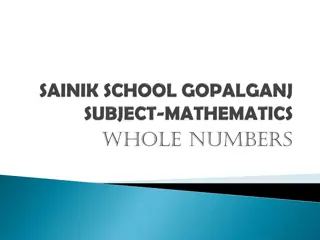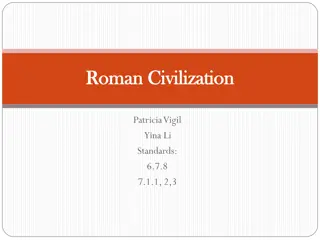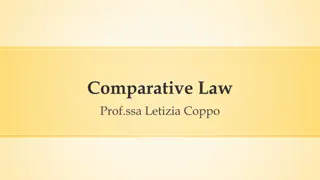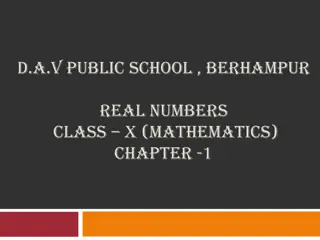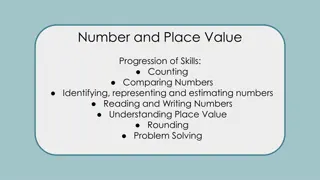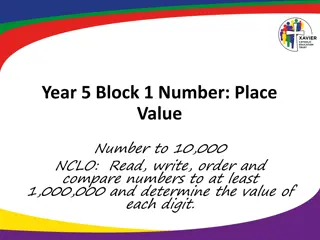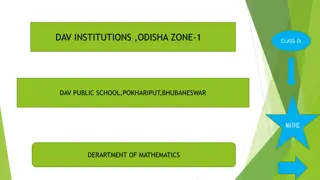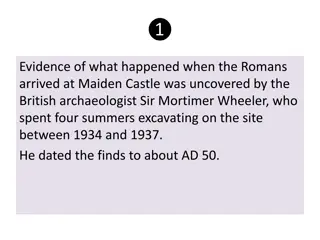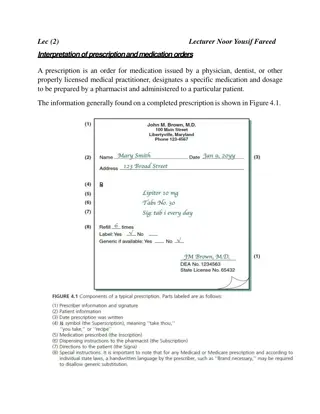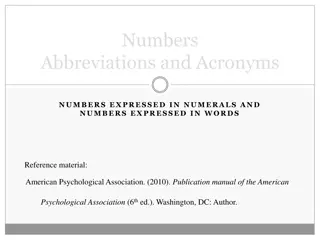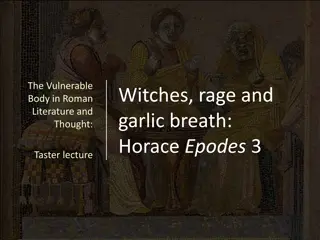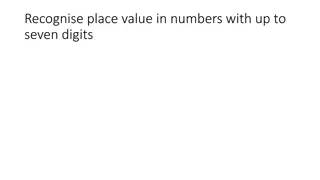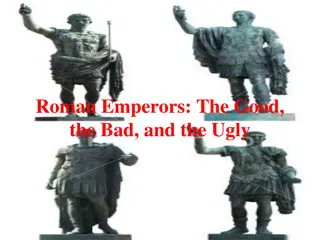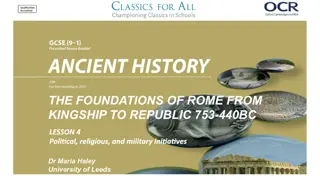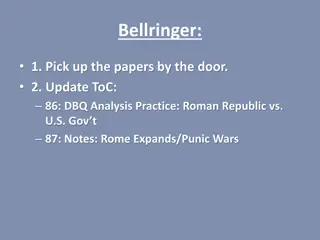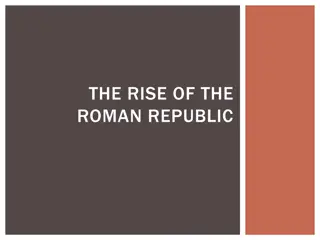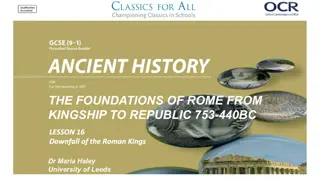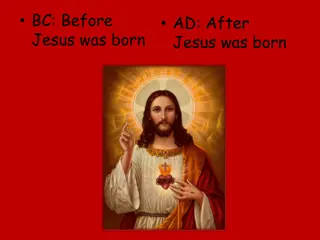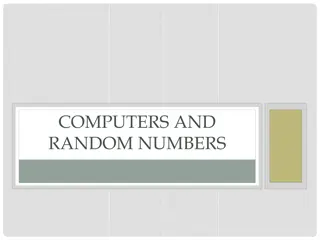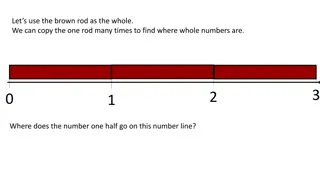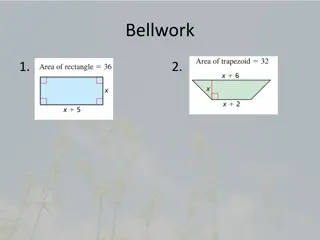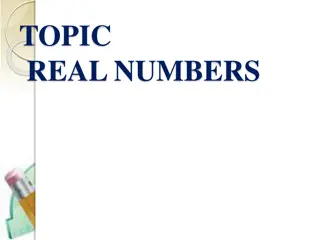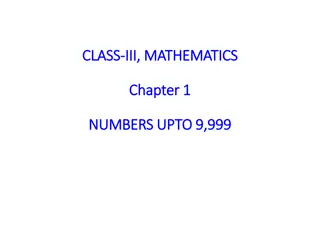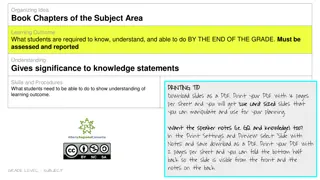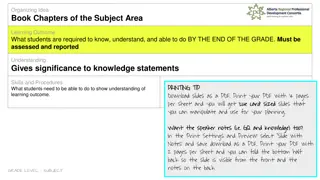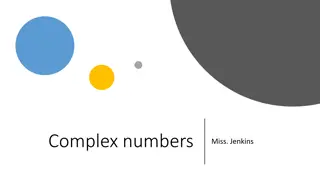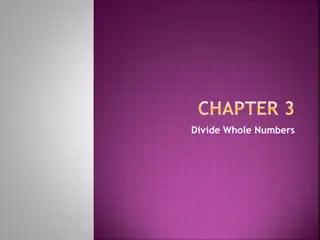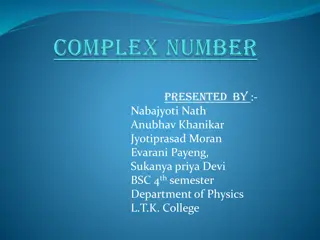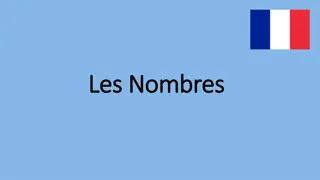Understanding Natural Numbers, Whole Numbers, and Roman Numerals
This chapter delves into the concepts of natural numbers, whole numbers, and Roman numerals. It covers the basics of numeral systems, properties of whole numbers, and rules for Roman numerals. Learn about counting numbers, place value, successors, predecessors, and more to build a strong mathematical foundation.
Download Presentation

Please find below an Image/Link to download the presentation.
The content on the website is provided AS IS for your information and personal use only. It may not be sold, licensed, or shared on other websites without obtaining consent from the author. Download presentation by click this link. If you encounter any issues during the download, it is possible that the publisher has removed the file from their server.
E N D
Presentation Transcript
CHAPTER CHAPTER 1 1 NATURAL NUMBERS AND WHOLE NUMBERS NATURAL NUMBERS AND WHOLE NUMBERS CLASS CLASS 6 6TH SUBJECT SUBJECT MATHEMATICS MATHEMATICS PREPARED BY PREPARED BY MRS KANANA BALA NAYAK MRS KANANA BALA NAYAK TH
INTRODUCTION INTRODUCTION The smallest natural number is one (1) . We cannot find greatest natural number . Natural numbers along with zero form the system of whole numbers. Every natural number is a whole number. A group of digits denoting a number is called a Numeral. To represent any number , we use ten symbols 0,1,2,3,4,5,6,7,8,9. These ten symbols are called digits or figures. If we add 1 to a whole number we get the next whole number called its successor. 1 less than a given whole number (other than zero), is called its predecessor. The whole number 0 does not have its predecessor. Every whole number other than zero has its predecessor. The face value of a digit remains as it is whatever place it may be occupying in the place value chart. The place value of a digit in a number is the product of the digit and its place. Number 1,2,3,4,5, . We used counting form the system of natural numbers(counting numbers).
ROMAN NUMERALS ROMAN NUMERALS Romans used a different set of symbols as their numerals. There are seven basic Roman Numerals. Roman Roman symbol symbol Meaning I I V V X X L L C C D D M M 1 5 10 50 100 500 1000 The following rules are observed in Roman Numerals. Rule 1: Rule 1:- - Rule of repetition Rule of repetition When a symbol is repeated twice or thrice, its value is multiplied by 2 or 3 respectively. EX :- M =1000 , MM =2 X 1000=2000 ,MMM =3X 1000=3000 Symbol :- I,X,C and M can be repeated three times at maximum. E.g.:- XXX=30 Symbol :- V,L and D are never repeated (i.e. symbols for 5,50 and 500 can not be repeated. Rule 2: Rule 2:- - Rule of addition Rule of addition If a symbol of smaller value is written to the right of a symbol of higher value ,we add the smaller value to the greater value. EX :- XI=10+1=11. 1. 2. 3.
Rule 3:Rule of subtraction Rule 3:Rule of subtraction If a symbol of smaller value is to the left of a symbol of higher value ,we subtract the smaller value from the higher value. EX : XC , X = 10 AND C =100 XC =100 10 =90 The symbols V , L ,D Cannot be subtracted from any number . EX : 95 =100-5 =VC (WRONG) , 95 = 90 +5 =XCV (CORRECT) I ,X, C are used to subtract. There are six combinations Ex : IV =5-1=4 , XL = 50-10 =40 , CD =500-100=400, EX: IX =10-1 =9 ,XC =100-10 =90 ,CM =1000-100=900 1. 2. 3.
ROMAN NUMERALS: ROMAN NUMERALS:- -
PROPERTIES OF WHOLE NUMBER PROPERTIES OF WHOLE NUMBER CLOSURE PROPERTY CLOSURE PROPERTY: The sum of two whole numbers is a whole number . EX :2+3 =5 :The product of two numbers is also a whole number. EX: 2 x3 =6 : The difference between two whole numbers may or may not be a whole number ex :3-2 =1 but 2-3 =-1 :If two whole numbers are divided their quotient may or may not be a whole number . COMMUTATIVE PROPERTY :The sum remains same even after changing the order of addends .Ex :45 +35 = 35 +45 :The product remains same even after changing the order of multiplier. Ex :12 x34 =34 x12 :This property is not required for subtraction and division of whole number, ASSOCIATIVE PROPERTY :The sum remains same when the grouping of addends is changed . Ex : (2+3)+5 =2+(3+5) 5+5 =2+8 10 =10 :The product remains same if three numbers multiplied in any grouping or order .Ex .(2x3)x4=2x(3x4) DISTRIBUTIVE PROPERTY : multiplication over addition 2 x(5+ 6) = (2 x5) +( 2 x6) = 10 + 12 =22 Ex . 252 x 101 = 252 x(100 +1) =(252 x100) +( 252 x 1) =25200 + 252 =25452
ESTIMATION OF SUM AND DIFFERENCE: ESTIMATION OF SUM AND DIFFERENCE:- -
ESTIMATE OF PRODUCT OF NUMBERS ESTIMATE OF PRODUCT OF NUMBERS Let us estimate : 52 x786 Solution : 52 Can be rounded off to the nearest ten as 50 :786 can be rounded off to the nearest hundred as 800 : Hence, the estimate the product =50 x800 =40,000 Note : To estimate the product ,round off each factor to its greatest place then multiply the rounded off factors.
DMAS RULE D Division ivision -------------- M Multiplication ultiplication------- A Addition ddition----------------- S Subtraction ubtraction----------- Mainly three brackets are used for solving numerical expressions. Mainly three brackets are used for solving numerical expressions. EX: 3 EX: 3 (5 (5- -6 6 3) =3 3) =3- -(5 (5- -2)=3 2)=3- -3=0 3=0 --------------First First -------Second Second -----------------Third Third -----------Last Last Brackets symbol Brackets symbol ( ) { } [ ] Name Name Round brackets Curly brackets Square brackets
EXTRA QUESTIONS ON CHAPTER -1 Write all 3 digit numbers using the digits 2,3,5.taking each digit only once. How many 5 digits numbers are there in all? Estimate the product :958 x387 Write the roman numeral for 1947 What comes just before 99,000. Write the number 3,08,927 in expanded form. Express the number 9,72,01,301 in words. What must be added to 34,52,629 to make it equal to 6 crore. Find the difference of the place value and face value of the digit 3 in 613728. Write all the two digit numbers which when added to 27 get reversed.


